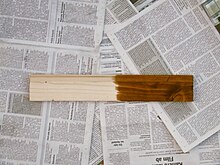Pickling (wood)
Under pickling is understood in the woodworking treating the surface with a pickling . The aim of the stain is primarily to change the color tone, but this can also serve to protect the surface against mold .
Goal setting
The staining of wooden surfaces can have various objectives:
- Emphasis or reinforcement of the natural color tone
- Change of shade
- Emphasis on contrasts in the wood grain
- Adjustment or equalization of the natural color shade
- Adjustment or equalization of color tones of different types of wood
Procedure
Two main processes are used in woodworking: dye staining and chemical staining.
With dye staining , powdery or liquid color pigments are applied to the surface in a suitable solution and soak into the wood. As more paint penetrates the softer parts of the wood, the grain appears as a negative afterwards. A further distinction is made between water stains and alcohol-soluble stains (spirit stains).
With chemical staining there is a chemical reaction with the ingredients of the stain and the wood. Since the harder late wood, which is richer in tannin, chemically binds more stain than the softer early wood, the grain is retained as a positive image. With a suitable choice of stain, the wood can not only be darkened, but also colored in a variety of tones.
Combination pickling
Smoke pickling: Causes very good pore pickling and emphasizes the pith rays very well (positive pickling image), but the color is not entirely lightfast. A well-known example is the smoked oak .
Bleaching stains : simultaneously applying a peroxidbeständigen stain and hydrogen peroxide natural dyes are bleached and the wood fed an artificial dye, whereby a much higher light resistance is achieved. Bleach stains are mainly used for wood that is not color stable, such as wenge , mansonia and American nut.
processing
The wood must be pretreated for staining. Since the wood fibers straighten up due to the watery stain, the wood is watered beforehand for a smooth surface and then finely sanded after drying.
Adhering grinding dust residues are removed with brushes that are fitted with bronze wire or a mixture of bronze wire and fiber . Any glue residue, "cross sanders" or the like, are immediately and clearly visible during the pickling process.
In any case, the stained surface must be protected from damage with the help of varnishing or glazing . Depending on the system used to treat the surface, the color of the surface changes again (in technical jargon this effect is called "cheering").
It is advisable to prepare stain samples from the material to be stained before the final staining and painting of the finished parts and to subject them to the complete surface treatment process.
Stain penetrates the surface, it is not a superficial layer that could flake off, deeper small damage can be re-colored.
literature
- Hans Michaelsen; Ralf Buchholz: About coloring wood: wood stains from antiquity to the present day. Literature, history, technology, reconstruction, 2000 recipes . Michael Imhof Verlag, Petersberg 2006, ISBN 3-86568-033-X
Individual evidence
- ^ Fritz Spannagel: Der Möbelbau (1954): A textbook for carpenters, architects, teachers and enthusiasts . HolzWerken, 2002, ISBN 978-3-87870-666-3 , p. 23–.
- ^ A b Kurt Schönburg: Wooden surfaces on buildings: properties, processing, design . Beuth Verlag, 4 June 2009, ISBN 978-3-410-16828-7 , p. 115–.
- ↑ Sam Allen: Surface Treatment of Wood: Classic Techniques and Recipes . HolzWerken, 2005, ISBN 978-3-87870-586-4 , pp. 95–.
- ↑ Sam Allen: Surface Treatment of Wood: Classic Techniques and Recipes . HolzWerken, 2005, ISBN 978-3-87870-586-4 , p. 106–.
